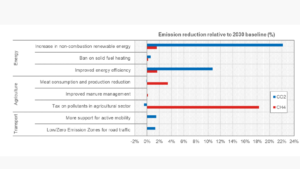New Report Confirms Action on Air Pollution Guarantees Triple Win
A groundbreaking study confirms that the EU can achieve its air quality objectives¹ on time by 2030 without the need for deadline extensions. Importantly, the study finds that air pollution policies deliver a triple win: for health, the environment, and climate.
Air pollution is Europe’s largest environmental health risk² contributing to chronic illnesses and premature deaths. This study underscores that by making the right choices and prioritising the adoption of key measures, Member States can meet their air quality commitments while securing major climate benefits.
Margherita Tolotto, Policy Manager Air and Noise, European Environmental Bureau, said:
This research proves that agreed air quality objectives can be achieved by 2030 while also benefiting the climate. Cutting emissions at the source is fundamental to reducing air pollution concentrations and protecting public health. There is no excuse for delay.
Key Findings of the Study:
- The EU can meet its air quality targets without deadline extensions.
- Tackling air pollution brings significant climate benefits.
- Reducing emissions at the source is essential—every sector must contribute.
- The economic perspective is promising, with potential benefits outweighing costs.
- Stronger national policies improve air quality across borders.
The study also highlights the clear co-benefits for climate action: implementing the 10 recommended measures by 2030 would lead to an estimated 32.5% reduction in CO₂ emissions and a 23.9% reduction in methane (CH₄) emissions across the EU-27. These results confirm that tackling air pollution and climate change go hand in hand.

[Figure 1: Emission reduction potential of key measures relative to the 2030 baseline scenario]
The chart above, taken from the study published today, illustrates the impact of the 10 measures selected for analysis on reducing CO₂ (blue) and CH₄ (red) emissions across the energy, agriculture, and transport sectors.
Notably, increasing the share of non-combustion renewable energy and improving energy efficiency show significant CO₂ reductions, while taxing agricultural pollutants and improving manure management lead to major CH₄ reductions. These findings reinforce the need for ambitious, sector-wide action to achieve cleaner air and climate benefits.
Margherita Tolotto, Policy Manager Air and Noise, European Environmental Bureau, added:
This study shows that the right choices will ensure the whole EU delivers on its air quality commitments while benefiting the climate.
Imagine being offered a glass of murky water versus a glass of clear water—which would you choose? We should strive for a future where no one is forced to settle for the polluted option. This study lays out a clear path to get us there, and we hope it will inspire further engagement and urgent action.
The study’s estimates are considered conservative, as modelling was conducted on a 50x50km scale across the EU. A more detailed, local analysis would likely reveal even greater health benefits and pollution reductions.
Notes:
- The Ambient Air Quality Directive (AAQD) is a cornerstone of European Union legislation aimed at regulating and improving air quality across Member States. Its primary objective is to protect human health and the environment by setting specific air quality standards and emission limits for various air pollutants, including particulate matter (PM10 and PM2.5), nitrogen dioxide (NO2), sulphur dioxide (SO2), carbon monoxide (CO), lead (Pb), benzene, and ozone (O3). In October 2022, the European Commission proposed a revised AAQD, with air quality limit values for PM2.5 and NO2 twice the value of the WHO guidelines, to be met by 2030. A clear pathway for full alignment with the WHO’s guidelines was missing.
- Air pollution is responsible for around 300,000 premature deaths annually in Europe, making it the foremost environmental threat to our health. Air pollution contributes to a wide range of health issues, including heart attacks, strokes, respiratory problems, diabetes, dementia, delayed cognitive development in children and lung cancer.

